Capstone Project: Analysis of Male Incarceration and its Impact
VerifiedAdded on 2022/09/18
|6
|1090
|40
Capstone Project
AI Summary
This capstone project provides a detailed description of the male population in correctional facilities, focusing on the increasing rates of incarceration in the United States. It examines the context of the problem, highlighting the high rates of incarceration among racial and ethnic minorities, and the impact on mental health, including depression, anxiety, and PTSD. The project explores the effects of incarceration on the environment, quality of care, and patient outcomes, emphasizing the challenges faced by healthcare professionals. It also discusses the significance of the issue, nursing implications, and strategies like drug treatment courts and awareness programs to mitigate the problem. The project concludes with a call for healthcare services, counseling, and the development of support systems to address the issue.
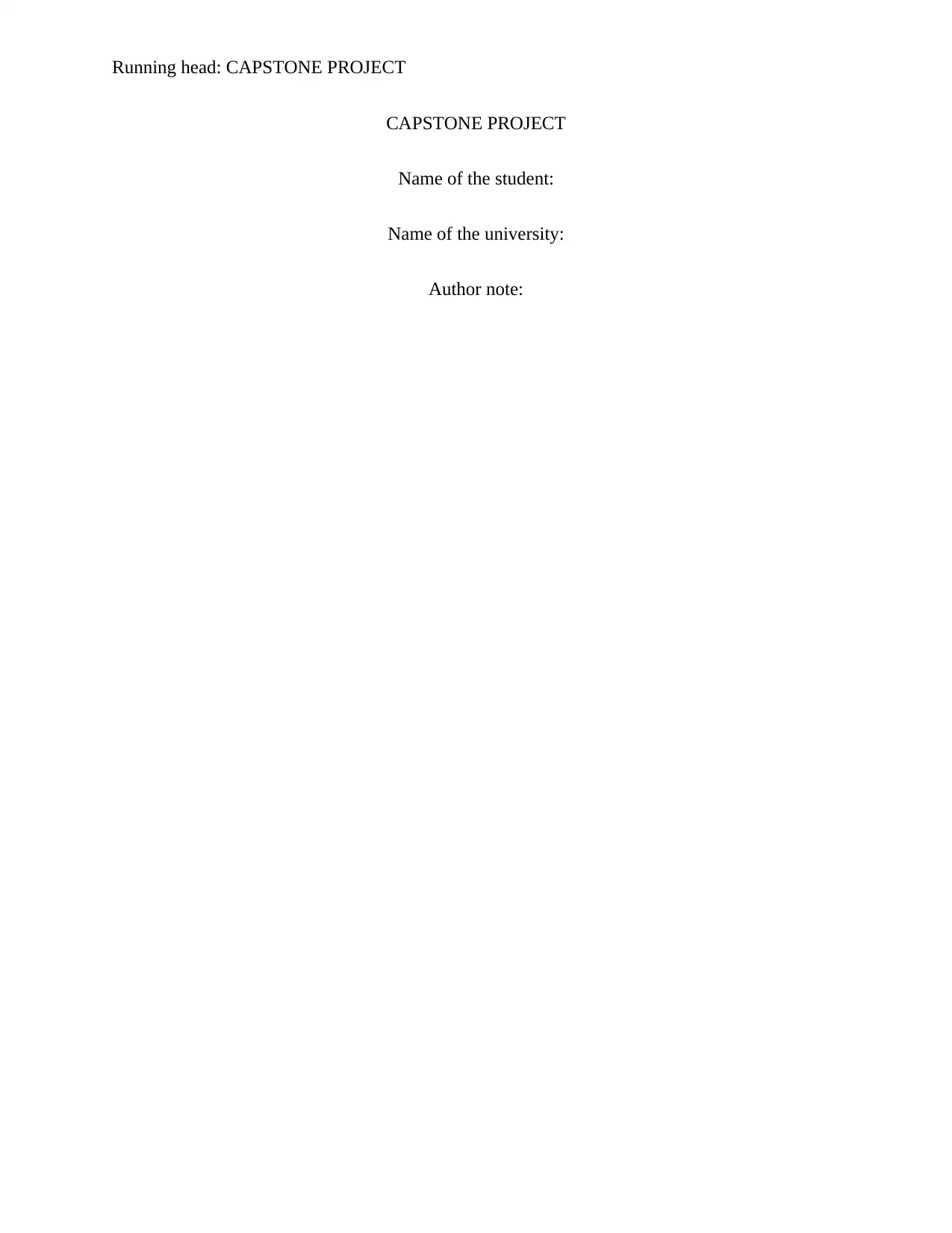
Running head: CAPSTONE PROJECT
CAPSTONE PROJECT
Name of the student:
Name of the university:
Author note:
CAPSTONE PROJECT
Name of the student:
Name of the university:
Author note:
Paraphrase This Document
Need a fresh take? Get an instant paraphrase of this document with our AI Paraphraser
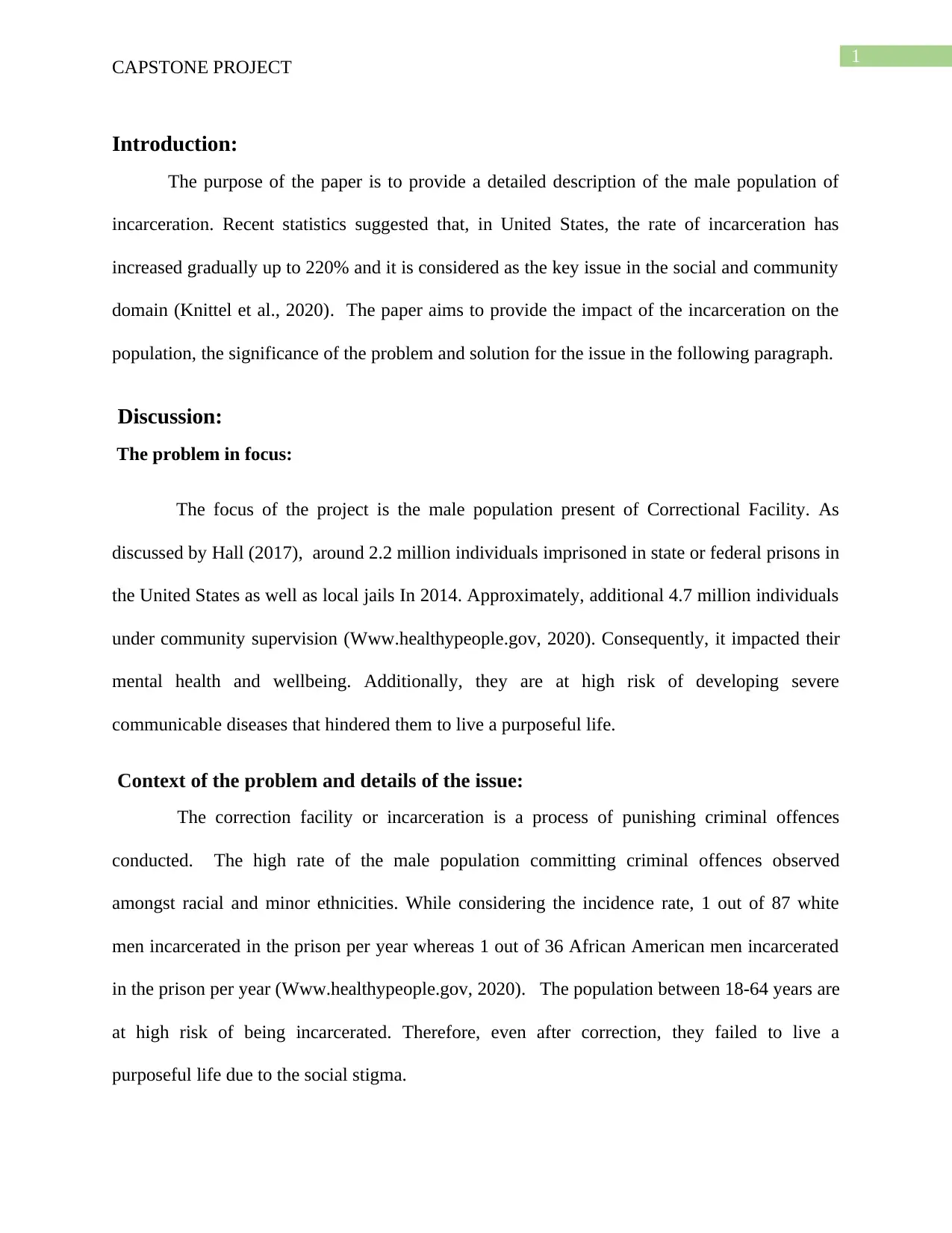
1
CAPSTONE PROJECT
Introduction:
The purpose of the paper is to provide a detailed description of the male population of
incarceration. Recent statistics suggested that, in United States, the rate of incarceration has
increased gradually up to 220% and it is considered as the key issue in the social and community
domain (Knittel et al., 2020). The paper aims to provide the impact of the incarceration on the
population, the significance of the problem and solution for the issue in the following paragraph.
Discussion:
The problem in focus:
The focus of the project is the male population present of Correctional Facility. As
discussed by Hall (2017), around 2.2 million individuals imprisoned in state or federal prisons in
the United States as well as local jails In 2014. Approximately, additional 4.7 million individuals
under community supervision (Www.healthypeople.gov, 2020). Consequently, it impacted their
mental health and wellbeing. Additionally, they are at high risk of developing severe
communicable diseases that hindered them to live a purposeful life.
Context of the problem and details of the issue:
The correction facility or incarceration is a process of punishing criminal offences
conducted. The high rate of the male population committing criminal offences observed
amongst racial and minor ethnicities. While considering the incidence rate, 1 out of 87 white
men incarcerated in the prison per year whereas 1 out of 36 African American men incarcerated
in the prison per year (Www.healthypeople.gov, 2020). The population between 18-64 years are
at high risk of being incarcerated. Therefore, even after correction, they failed to live a
purposeful life due to the social stigma.
CAPSTONE PROJECT
Introduction:
The purpose of the paper is to provide a detailed description of the male population of
incarceration. Recent statistics suggested that, in United States, the rate of incarceration has
increased gradually up to 220% and it is considered as the key issue in the social and community
domain (Knittel et al., 2020). The paper aims to provide the impact of the incarceration on the
population, the significance of the problem and solution for the issue in the following paragraph.
Discussion:
The problem in focus:
The focus of the project is the male population present of Correctional Facility. As
discussed by Hall (2017), around 2.2 million individuals imprisoned in state or federal prisons in
the United States as well as local jails In 2014. Approximately, additional 4.7 million individuals
under community supervision (Www.healthypeople.gov, 2020). Consequently, it impacted their
mental health and wellbeing. Additionally, they are at high risk of developing severe
communicable diseases that hindered them to live a purposeful life.
Context of the problem and details of the issue:
The correction facility or incarceration is a process of punishing criminal offences
conducted. The high rate of the male population committing criminal offences observed
amongst racial and minor ethnicities. While considering the incidence rate, 1 out of 87 white
men incarcerated in the prison per year whereas 1 out of 36 African American men incarcerated
in the prison per year (Www.healthypeople.gov, 2020). The population between 18-64 years are
at high risk of being incarcerated. Therefore, even after correction, they failed to live a
purposeful life due to the social stigma.
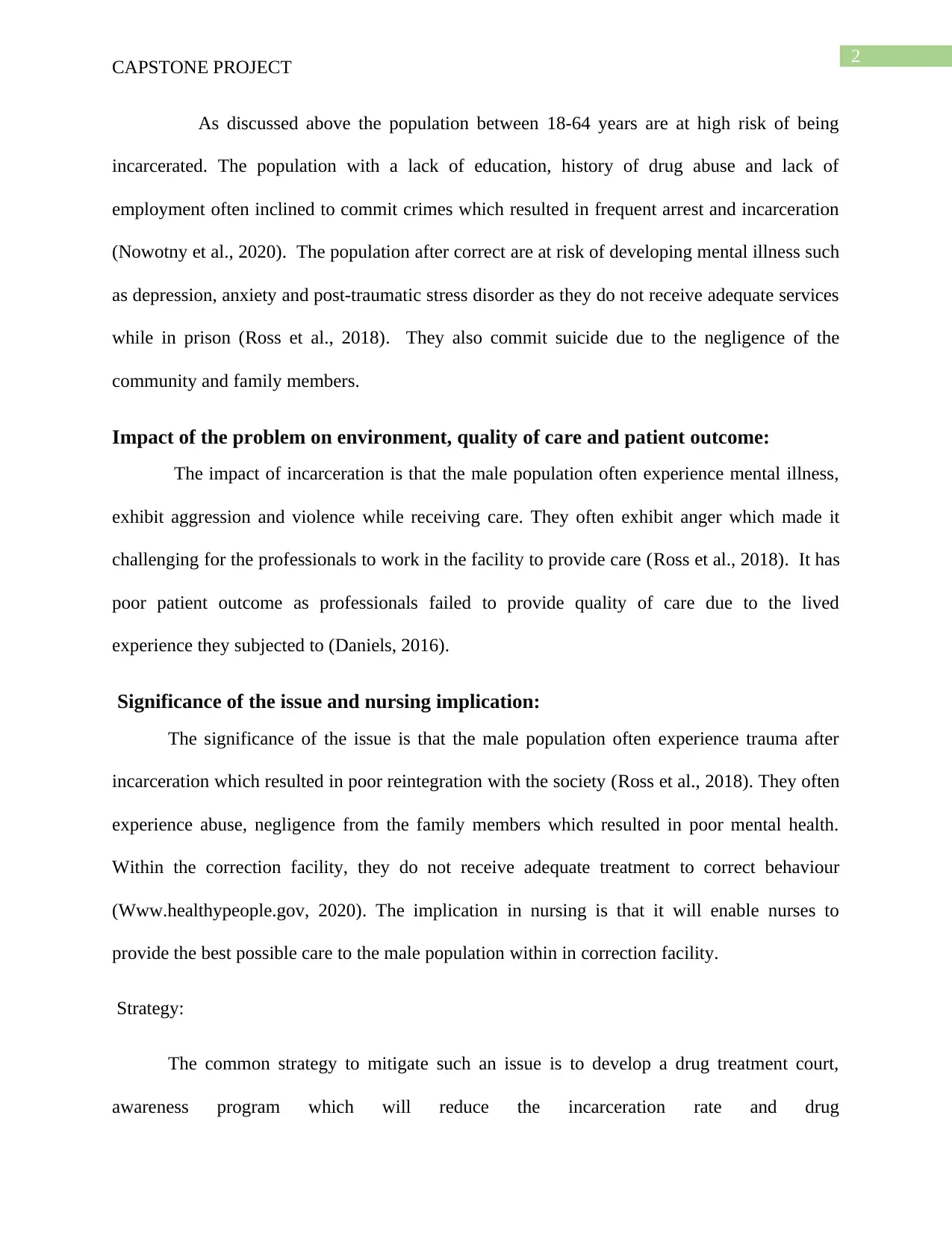
2
CAPSTONE PROJECT
As discussed above the population between 18-64 years are at high risk of being
incarcerated. The population with a lack of education, history of drug abuse and lack of
employment often inclined to commit crimes which resulted in frequent arrest and incarceration
(Nowotny et al., 2020). The population after correct are at risk of developing mental illness such
as depression, anxiety and post-traumatic stress disorder as they do not receive adequate services
while in prison (Ross et al., 2018). They also commit suicide due to the negligence of the
community and family members.
Impact of the problem on environment, quality of care and patient outcome:
The impact of incarceration is that the male population often experience mental illness,
exhibit aggression and violence while receiving care. They often exhibit anger which made it
challenging for the professionals to work in the facility to provide care (Ross et al., 2018). It has
poor patient outcome as professionals failed to provide quality of care due to the lived
experience they subjected to (Daniels, 2016).
Significance of the issue and nursing implication:
The significance of the issue is that the male population often experience trauma after
incarceration which resulted in poor reintegration with the society (Ross et al., 2018). They often
experience abuse, negligence from the family members which resulted in poor mental health.
Within the correction facility, they do not receive adequate treatment to correct behaviour
(Www.healthypeople.gov, 2020). The implication in nursing is that it will enable nurses to
provide the best possible care to the male population within in correction facility.
Strategy:
The common strategy to mitigate such an issue is to develop a drug treatment court,
awareness program which will reduce the incarceration rate and drug
CAPSTONE PROJECT
As discussed above the population between 18-64 years are at high risk of being
incarcerated. The population with a lack of education, history of drug abuse and lack of
employment often inclined to commit crimes which resulted in frequent arrest and incarceration
(Nowotny et al., 2020). The population after correct are at risk of developing mental illness such
as depression, anxiety and post-traumatic stress disorder as they do not receive adequate services
while in prison (Ross et al., 2018). They also commit suicide due to the negligence of the
community and family members.
Impact of the problem on environment, quality of care and patient outcome:
The impact of incarceration is that the male population often experience mental illness,
exhibit aggression and violence while receiving care. They often exhibit anger which made it
challenging for the professionals to work in the facility to provide care (Ross et al., 2018). It has
poor patient outcome as professionals failed to provide quality of care due to the lived
experience they subjected to (Daniels, 2016).
Significance of the issue and nursing implication:
The significance of the issue is that the male population often experience trauma after
incarceration which resulted in poor reintegration with the society (Ross et al., 2018). They often
experience abuse, negligence from the family members which resulted in poor mental health.
Within the correction facility, they do not receive adequate treatment to correct behaviour
(Www.healthypeople.gov, 2020). The implication in nursing is that it will enable nurses to
provide the best possible care to the male population within in correction facility.
Strategy:
The common strategy to mitigate such an issue is to develop a drug treatment court,
awareness program which will reduce the incarceration rate and drug
⊘ This is a preview!⊘
Do you want full access?
Subscribe today to unlock all pages.

Trusted by 1+ million students worldwide
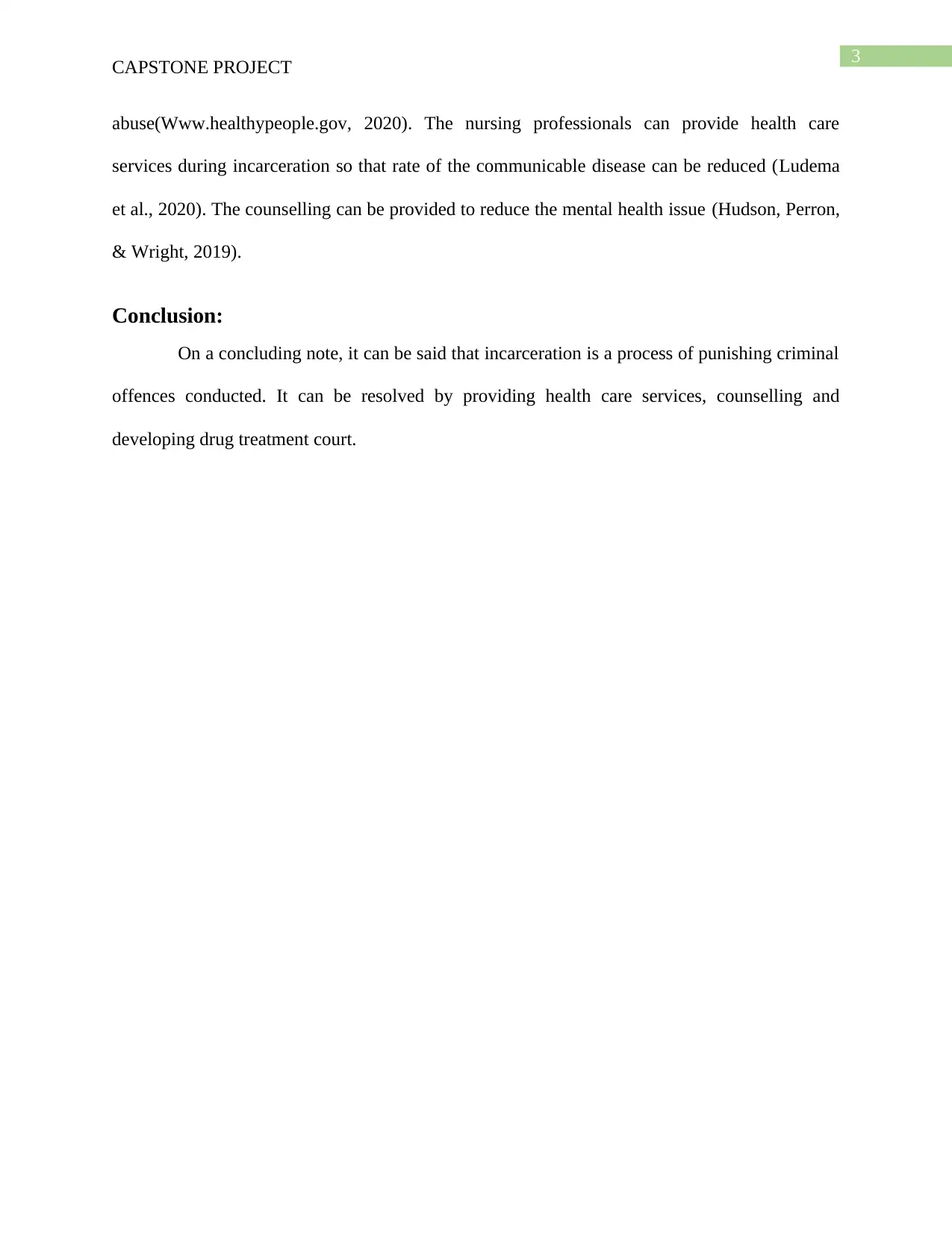
3
CAPSTONE PROJECT
abuse(Www.healthypeople.gov, 2020). The nursing professionals can provide health care
services during incarceration so that rate of the communicable disease can be reduced (Ludema
et al., 2020). The counselling can be provided to reduce the mental health issue (Hudson, Perron,
& Wright, 2019).
Conclusion:
On a concluding note, it can be said that incarceration is a process of punishing criminal
offences conducted. It can be resolved by providing health care services, counselling and
developing drug treatment court.
CAPSTONE PROJECT
abuse(Www.healthypeople.gov, 2020). The nursing professionals can provide health care
services during incarceration so that rate of the communicable disease can be reduced (Ludema
et al., 2020). The counselling can be provided to reduce the mental health issue (Hudson, Perron,
& Wright, 2019).
Conclusion:
On a concluding note, it can be said that incarceration is a process of punishing criminal
offences conducted. It can be resolved by providing health care services, counselling and
developing drug treatment court.
Paraphrase This Document
Need a fresh take? Get an instant paraphrase of this document with our AI Paraphraser
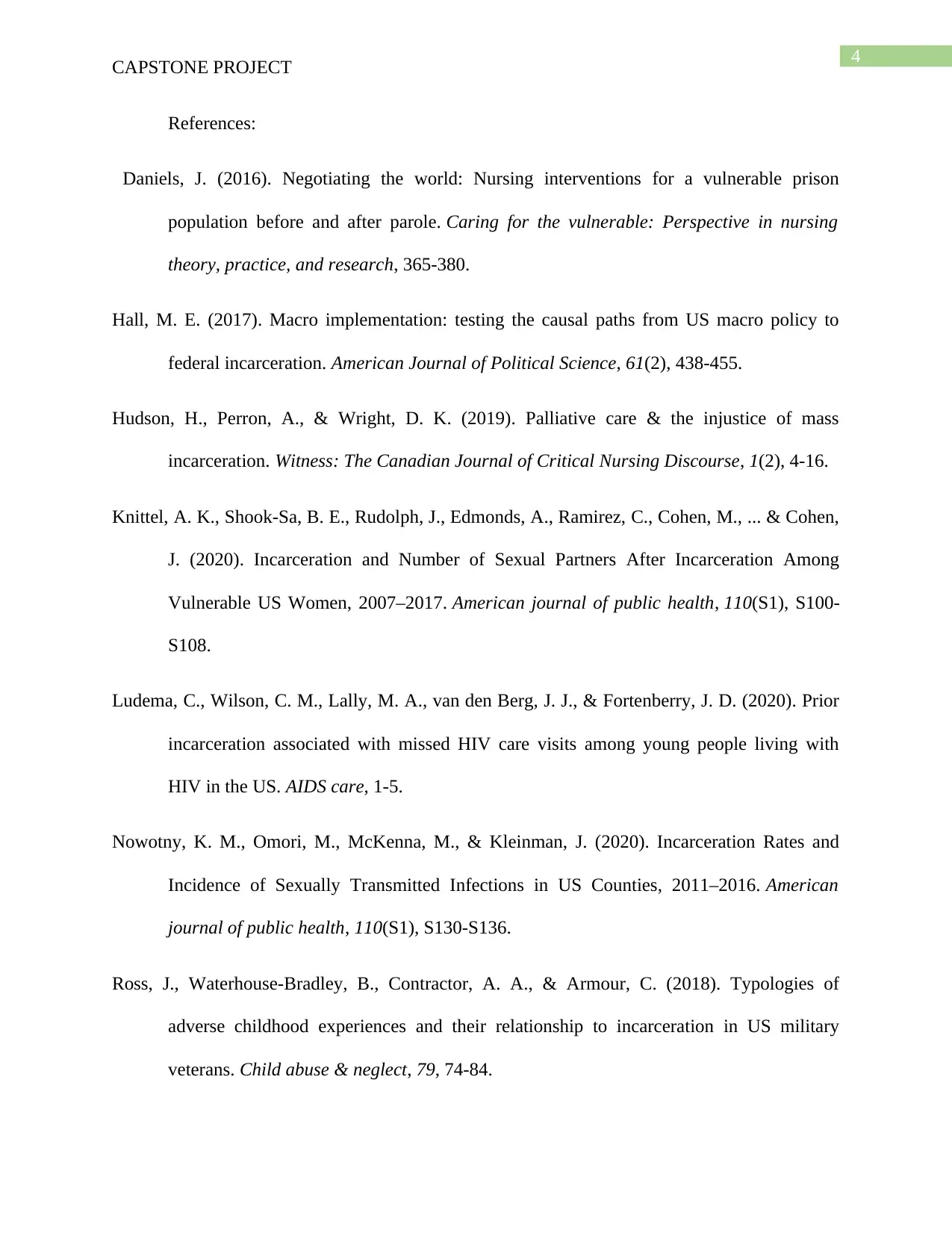
4
CAPSTONE PROJECT
References:
Daniels, J. (2016). Negotiating the world: Nursing interventions for a vulnerable prison
population before and after parole. Caring for the vulnerable: Perspective in nursing
theory, practice, and research, 365-380.
Hall, M. E. (2017). Macro implementation: testing the causal paths from US macro policy to
federal incarceration. American Journal of Political Science, 61(2), 438-455.
Hudson, H., Perron, A., & Wright, D. K. (2019). Palliative care & the injustice of mass
incarceration. Witness: The Canadian Journal of Critical Nursing Discourse, 1(2), 4-16.
Knittel, A. K., Shook-Sa, B. E., Rudolph, J., Edmonds, A., Ramirez, C., Cohen, M., ... & Cohen,
J. (2020). Incarceration and Number of Sexual Partners After Incarceration Among
Vulnerable US Women, 2007–2017. American journal of public health, 110(S1), S100-
S108.
Ludema, C., Wilson, C. M., Lally, M. A., van den Berg, J. J., & Fortenberry, J. D. (2020). Prior
incarceration associated with missed HIV care visits among young people living with
HIV in the US. AIDS care, 1-5.
Nowotny, K. M., Omori, M., McKenna, M., & Kleinman, J. (2020). Incarceration Rates and
Incidence of Sexually Transmitted Infections in US Counties, 2011–2016. American
journal of public health, 110(S1), S130-S136.
Ross, J., Waterhouse-Bradley, B., Contractor, A. A., & Armour, C. (2018). Typologies of
adverse childhood experiences and their relationship to incarceration in US military
veterans. Child abuse & neglect, 79, 74-84.
CAPSTONE PROJECT
References:
Daniels, J. (2016). Negotiating the world: Nursing interventions for a vulnerable prison
population before and after parole. Caring for the vulnerable: Perspective in nursing
theory, practice, and research, 365-380.
Hall, M. E. (2017). Macro implementation: testing the causal paths from US macro policy to
federal incarceration. American Journal of Political Science, 61(2), 438-455.
Hudson, H., Perron, A., & Wright, D. K. (2019). Palliative care & the injustice of mass
incarceration. Witness: The Canadian Journal of Critical Nursing Discourse, 1(2), 4-16.
Knittel, A. K., Shook-Sa, B. E., Rudolph, J., Edmonds, A., Ramirez, C., Cohen, M., ... & Cohen,
J. (2020). Incarceration and Number of Sexual Partners After Incarceration Among
Vulnerable US Women, 2007–2017. American journal of public health, 110(S1), S100-
S108.
Ludema, C., Wilson, C. M., Lally, M. A., van den Berg, J. J., & Fortenberry, J. D. (2020). Prior
incarceration associated with missed HIV care visits among young people living with
HIV in the US. AIDS care, 1-5.
Nowotny, K. M., Omori, M., McKenna, M., & Kleinman, J. (2020). Incarceration Rates and
Incidence of Sexually Transmitted Infections in US Counties, 2011–2016. American
journal of public health, 110(S1), S130-S136.
Ross, J., Waterhouse-Bradley, B., Contractor, A. A., & Armour, C. (2018). Typologies of
adverse childhood experiences and their relationship to incarceration in US military
veterans. Child abuse & neglect, 79, 74-84.

5
CAPSTONE PROJECT
Www.healthypeople.gov(2020). Incarceration30 March 2020, from
https://www.healthypeople.gov/2020/topics-objectives/topic/social-determinants-health/
interventions-resources/incarceration
CAPSTONE PROJECT
Www.healthypeople.gov(2020). Incarceration30 March 2020, from
https://www.healthypeople.gov/2020/topics-objectives/topic/social-determinants-health/
interventions-resources/incarceration
⊘ This is a preview!⊘
Do you want full access?
Subscribe today to unlock all pages.

Trusted by 1+ million students worldwide
1 out of 6
Related Documents
Your All-in-One AI-Powered Toolkit for Academic Success.
+13062052269
info@desklib.com
Available 24*7 on WhatsApp / Email
![[object Object]](/_next/static/media/star-bottom.7253800d.svg)
Unlock your academic potential
Copyright © 2020–2025 A2Z Services. All Rights Reserved. Developed and managed by ZUCOL.



